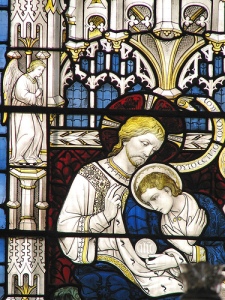The Gospel of John is of particular interest to queer people of faith for its repeated references to the “beloved disciple”, or to “the disciple that Jesus loved”. These references make clear that whoever he was, this disciple had a relationship with Jesus of particular intimacy. There’s the well-known scene from the Last Supper where he rests his head on Jesus’ breast (or lap), and at the crucifixion, he is the only man standing among the women at the foot of the cross. He is the one to whom Christ entrusts the care of his mother – rather as a surviving spouse in marriage would assume some responsibility for the care of a mother-in-law. The existence of this special relationship provides much of the argument for the proposition that Jesus’ sexual orientation may have been what we call “gay”.

The beloved disciple is not explicitly named, but is often assumed to be John himself. I have written before on these lines, using “John, the Beloved Disciple” as a jumping off point for a reflection on the gay Jesus:
For gay men in particular, combining this thought in our prayer with a recognition of Jesus’ full bodily humanity can be a powerful entry into building that important personal relationship with him in our spiritual lives.
……….
The significance for us of John as “the disciple Jesus loved”, goes way beyond the possibility of genital activity. Love is primarily an emotional relationship, not a physical one. The English language does us a disservice in using “lovemaking” as a euphemism for the physical act, even without any deep emotional significance. “Loving”, in its full sense is more important than mere “lovemaking” as a physical act. In this sense, we know without any possible doubt that the words “whom Jesus loved” are true. How do we know it? Because they are true for all the disciples, as they are for each of us, and for all others.
But this does not do full justice to the importance of John himself. He may not, after all, be the person described. (Theodore Jennings, who has written most extensively on the subject, believes he is not). In any case, focussing on Jesus in the relationship ignores John, whose feast day it is. There are other reasons for thinking of John the Evangelist as queer.
After Jesus had left the earth, John had a further notable and intimate (at least emotionally so) relationship with another male disciple, this time younger than he – his disciple and scribe, Prochorus, bishop of Nicomedia. (Prochorus in turn, later formed a fresh relationship of his own with a younger man, Irenaeus,)
 |
| John the Evangelist, with his scribe Prochorus |
Then there’s the nature of John’s Gospel itself. Even the most cursory comparison of the four Gospels notes that it stands apart from the other three. The Gospels of Matthew, Mark and Luke share a common perspective and so are called the “synoptic” Gospels. That of John is quite different. It is often noted that gay men, as social outsiders, offer a unique view and special insight on the world and social relationships, possibly explaining the high proportion of gay men among the most acclaimed writers and artists in human history. This Gospel is written from the perspective of the beloved disciple – John states clearly that it is written from his witness. Even if John is not himself the beloved disciple, it is notable that it is in his Gospel, and not the Synoptics, that this relationship is recorded. Is this because, being gay himself, John saw something with his queer view (his “gaydar”) that the others did not? In his commentary on John (in The Queer Bible Commentary ), Robert Goss describes it unambiguously as the queerest Gospel, because it as a coming out story – that of God coming out, through Christ, to his people, because it is in John that Christ is presented as most gender fluid.
), Robert Goss describes it unambiguously as the queerest Gospel, because it as a coming out story – that of God coming out, through Christ, to his people, because it is in John that Christ is presented as most gender fluid.
Finally, let us recall again that in medieval Northern Europe, there was even a long-standing tradition that John and Christ were the bridal couple at the Cana Wedding Feast. This image of a marriage between Christ and John reminds us that in the mystical tradition of the Church, the established image of the Christian as the spouse of Christ is available to gay men, as “bridegrooms of Christ“, just as much as it is to women, as “brides of Christ”.
John, the queer Evangelist, is a powerful reminder to us as LGBT people that Christ numbered among his close followers and leaders of the church, people whose emotional and sexual lives did not conform to the conventional stereotypes of the day. In addition to John, we have the examples of Martha and Mary, of Lazarus (who is also named as a possible claimant to the title “beloved disciple”), Philip the Ethiopian Eunuch, and the Roman centurion. We too, likewise have a claim to be fully included in the modern Church, and to take any leadership roles for which our talents equip us.
Books:
Related articles
51.095649
-0.712811




